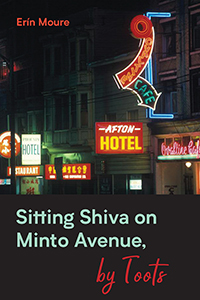Reviews
Nonfiction Review by Linda Rogers
Erin Moure, Sitting Shiva on Minto Avenue, by Toots (Vancouver: New Star, 2017). Paperbound, 141 pp., $21.
 Sitting Shiva on Minto Avenue is a book of sorrow that bears comparison to the great ones, among them Didion's The Year of Magical Thinking, White's Once and Future King, Milton's "Lycidas," and, recently, a slim but not slight volume of poetry, City Poems, by forensic reporter Joe Fiorito, who mourns The Invisible Ones.
Sitting Shiva on Minto Avenue is a book of sorrow that bears comparison to the great ones, among them Didion's The Year of Magical Thinking, White's Once and Future King, Milton's "Lycidas," and, recently, a slim but not slight volume of poetry, City Poems, by forensic reporter Joe Fiorito, who mourns The Invisible Ones.
Moure's journal of grief, the seven days of shiva, sitting in for a lost loved one, is a spare but deeply felt journey of recollection, the anodyne for a savage sadness. In her book of days, she gives substance to a forgotten man, the mysterious love of her younger life. It begins with the naming, by Toots, her former self, of The Little Man,
Paul Émile Savard, Métis inheritor of the trauma of mixed-blood habitants who were coerced by the Catholic Church to be colonists on their own land. Now we know, from grief specialist Gabor Mate of Saint Paul's Hospital, how experiences like this impede us as social beings.
The Little Man has died, not in his bedbug-infested room in the East End of Vancouver, but in Saint Paul's, which ministers to the forgotten, the physical and psychological victims of the "global village," in reality a global refugee camp.
Moure, who long ago hit "the road," a train trip to her present self: scholar, writer, translator, and lover of women, deconstructs the present to reveal the forgotten past, its architecture and language, the taste of memory. In doing this, she rediscovers her primal identity. In The Little Man's violence, she finds tenderness. In his diminishment, she reveals an angel, someone to be cherished.
Jews speak of the dead "of blessed memory." Moure, who understands the stations of the cross as well as she comprehends the meaning of shiva and the rending of cloth, blesses the locus of his path, through restaurants, condemned hotels, and railway cars where he gave service across the country. In doing this, she crosses every chakra from groin to spirit, the country of being, every space he inhabited made sacred. It is a learning process she supports with Internet research and the bird's-eye view of seraphim, the angels who bring fire and fiery language, poetry. And as "daffodillies fill their cups with tears," the rain brings relief and new life.
Minto, in Galician, means "I am lying." The author of this book of memory determines to set it down as accurately as she can, researching the past from her room on the other side of their shared world. In the gathering of details she summons her personal scholar, the woman who ran away from violence, alcoholism, and possibly the pure flame of love, to save the book of her life from immolation in the guilty crucible of our country built on the false premise, "Love thy neighbour as thyself."
As T. H. White wrote: “‘The best thing for being sad,’ replied Merlyn, beginning to puff and blow, ‘is to learn something. That is the only thing that never fails. You may grow old and trembling in your anatomies, you may lie awake at night listening to the disorder in your veins, you may miss your only love, you may see the world about you devastated by evil lunatics, or know your honour trampled in the sewer of baser minds. There is only one thing for it then—to learn.’”
In Milton's pastoral elegy, we learn the irony of hope. There was no future for former habitants now farming urban dumpsters, only the present, The Little Man's optimism, imprecating streetlights, "Shine on me, little star." If religion is celestial navigation, it provides strange maps for the disenfranchised. Moure finds her own belief system, poetry, as her book moves from the deep structure of language, phenomenal details, songs without words, to the eloquence of Rilke, whom she quotes: "The more human love (a love infinitely considerate and quiet) is one which we prepare painfully and with struggle, so that two solitudes may protect, border and greet each other."
Greetings between passing trains, waves from windows that separate us from landscape, life in photographic frames, the sadness of railway stations, and exhilaration of the journey tell one story with infinite permutations. And then we die as we have lived, alone, labouring for the birth or rebirth of the self.
The enemy is stasis and she recalls Hannah Arendt's banality of evil in her advocacy for action, the "keeping on" that defies human vulnerability. This is her credo, and her grief moves her forward, the past moving into the present like a runaway train. Riding with grace is her desideratum. "This is what I mean by wanting to say ethics when I mean purpose and goodness."
The two spirits conjoined by this memento mori travelled in different directions, but the poet's painstaking recreation of the journey in a book that is also a collage, a reconstruction of the map, fragments that have appeared in poems throughout her life as a writer, is coherent, a testimony to love and the existence of someone who mattered and still does, in blessed memory.
Weep no more, woeful shepherds, weep no more,
For Lycidas your sorrow is not dead,
Sunk though he be beneath the watery floor,
So sinks the day-star in the ocean bed,
And yet anon repairs his drooping head….
—Linda Rogers









